Recent Updates
- About Wolss: An 18th-century revival
Reconnecting with expressive type sketching -
On Letting Things Be Messy
Thoughts on process over perfection -
Studio Update
Notes on current projects and mindset
About Wolss: An 18th-century revival
Wolss is a revival based on Groote Augustyn Romyn cut in 1760 by the Flemish punchcutter Jan Baptist van Wolsschaten (1714–1776). The face is relatively light compared to its eighteenth-century contemporaries, features narrow proportions and sharp details in its design. The digital interpretation reflects findings of a thorough research of the original type and printed materials preserved in the collection of Museum Plantin-Moretus in Antwerp, Belgium. The underlying grid system used in this Baroque type is reminiscent of Renaissance foundry type production methods, and is also applied to the final revival. Wolss currently includes a text style suitable for use in small sizes and also a display version emphasizing the characteristic design details found in the original punches.
Research
Wolss is a revival of Groote Augustyn Romyn cut in 1760 by the Flemish punchcutter Jan Baptist van Wolsschaten (1714–1776) who was a member of the Van Wolsschaten family of printers and type-founders in Antwerp. The original matrices and punches are preserved in the collection of Museum Plantin-Moretus along with historical type specimens and books showing printed samples of the type. The target size of Groote Augustyn Romyn is about 12 pica points making the original type suitable for text use. The face is relatively light compared to its eighteenth-century contemporaries, features narrow proportions and sharp details in its design.
The examination of the matrices supports Dr. Frank E. Blokland’s1 dissertation about the standardised production methods in historical foundry type: Matrix widths were standardised and justified for fixed registers, and a stem-based unitisation system could be distilled. This system could be used for setting the ratios for x-height and ascenders/descenders, and fitting (spacing).
Development of the text style
The unitisations derived from the matrices were initially used as a basis for the digital drawings; however, the result proved to be too light to read comfortably when set in text sizes. Although the punches and matrices were delicate in places, the ink spread as a result of the printing process caused emboldening of the type. In order to reflect this effect, historical prints were used to recalculate the unitisation system.
A square-grid was then formed based on these units and used as a framework during the design process. Since the matrix widths were standardised, it was possible to set the character widths with the help of the unitisation system and therefore reproduce digitally the original fitting of the type.
Development of the display style
Whilst the type was made darker to be used for text purposes at small sizes, the original extremities of the type were moderated as a result of the lowered contrast. Details such as the hairline joints and sharp serifs were toned down in order to improve reading.
As a consequence, a higher contrast display version of the type was also worked on which would incorporate these formal details. For the display, the punches were taken as a basis whereas for the text, printed materials were referred to considering the ink spread. Additionally, further exaggerations in the details were added for emphasis in the display style.
Italic exploration
The 1775 specimen signed by Van Wolsschaten also features a matching italic for Groote Augustyn Romyn, titled Groote Augustyn Corsyf. According to John Lane2, this italic was cut soon after the roman, based on a survey of the surviving specimens.
Wolss family
The future plans for Wolss is to extend the Latin character set for modern use and complete a family of three styles: Text, display and italic.The text and display styles are set on a variable optical size axis allowing control of the contrast flow by modulating the height of the serifs and the thickness of the thin strokes. The design goal for the italic is to complement the text style as it was originally cut by the Van Wolsschaten.
Wolss typeface was designed and developed during the Expert class Type design 2021–22 at the Plantin Institute of Typography. I would like to thank Dr. Frank E. Blokland for his guidance and supervision, and Jan Van der Linden, Bart Van Put and Museum Plantin-Moretus for their help and support throughout the project.


Image 2: Detail of Horae Diurnae, 1771, showing the type in use for the text of the book.
The widths of the matrices were standardised by units of the stem width as illustrated in the letter /n. Matrices were also justified for fixed registers as marked above in red. A stem-based unitisation system could be distilled also for setting the body size ratios: x-height was calculated 12 units and the ascenders/descenders were equally 7 units.
The character widths could be defined by the underlying unitisation system and an overlay of the matrices on the printed materials shows how the fittings for both match.
Expert class Type design: Exhibition
This year, I attended the Expert class Type design 2021–22 course led by Dr. Frank E. Blokland at the Plantin Institute of Typography in Antwerp, Belgium.
For our final projects, we individually designed and developed a type revival of our choice. Wolss is my resulting typeface based on Groote Augustyn Romyn (about 12 points) cut in 1760 by the Flemish punchcutter Jan Baptist van Wolsschaten (1714–1776) who was a member of the Van Wolsschaten family of printers and type-founders in Antwerp. The original matrices and punches are preserved in the collection of Museum Plantin-Moretus along with historical type specimens and books showing printed samples of the type, and were used for my research to develop the final digital typeface.
As part of the course, we have also worked together as a group to research and revive two roman-type models by the famous French punchcutter Claude Garamont (ca.1510–1561). The types we studied were Gros Canon Romain (41 points) and Bible Romaine (7 points), two models in opposite extremes of body size, to map out any differences in foundry type with regard to the basic structure and patterns that can be observed between a text and a display size.
Our results will be shown at the Museum Plantin-Moretus in Antwerp from 16 August to 25 September in the exhibition, “In Plantin’s Footsteps”.
The character widths could be defined by the underlying unitisation system and an overlay of the matrices on the printed materials shows how the fittings for both match.